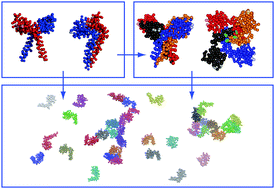Patch formation of a viral channel forming protein within a lipid membrane – Vpu of HIV-1†
Abstract
Ion channels and their viral companions are defined by their quaternary structure. The individual sub-units have to assemble into homo- or hetero-oligomers. Using Vpu of HIV-1, a putative viral channel forming protein (VCP), as a test case, the formation of a quaternary structure is monitored using coarse grained molecular dynamics (CGMD) simulations. Full length Vpu is generated by combining the helical transmembrane domain (TMD) with the cytoplasmic domain derived from NMR spectroscopy. Patches of 2 to 6 as well as patches of 16 and 32 Vpu proteins, Vpu-WT, containing unphosphorylated serines 52 and 56 are used to study assembly dynamics. The same patches are simulated for the Vpu double mutant, Vpu-DD, in which the two serines 52 and 56 are replaced by aspartic acid. Serines 52 and 56 in Vpu-WT allow short lived contacts between the cytoplasmic domains. Dimer formation is the first step for long lasting assemblies and is induced by the EYR motif. Roll-over movements allow rearrangement within the dimer. Independent of the number of Vpu proteins, Vpu-DD prefers smaller aggregates than Vpu-WT. In the case of simulation of 4 Vpu-WT proteins a pore-like assembly is directly identified with the TMD Ser-23 pointing towards a putative central pore axis.


 Please wait while we load your content...
Please wait while we load your content...